
Features
Production
Research
Crop load, nutrient management practices to prevent bitter pit in Honeycrisp
May 1, 2017 By Penn State University Extension
 Shoot length was a primary predictor of bitter pit. Photo bt T. Baugher, Penn State
Shoot length was a primary predictor of bitter pit. Photo bt T. Baugher, Penn StateMay 1, 2017, State College, PA – During multiple years of research on bitter pit in commercial Honeycrisp orchards, incidence was associated with low calcium levels in fruit peel; high ratios of nitrogen, potassium, and/or magnesium to calcium in fruit peel; excessive terminal shoot length; and low crop load. Heat and water stress predisposed Honeycrisp to bitter pit in 2016, and incidence was also highly correlated to excessive fruit size. Total actual calcium applied per season was inversely related to bitter pit, with the best suppression of bitter pit being with at least 8 lb and the source being calcium chloride.
Key findings to consider:
- Fruit calcium levels of 0.04 to 0.05 per cent were associated with the lowest bitter pit levels in Honeycrisp. Whereas most apple varieties have fruit calcium levels of 0.05 to 0.06 per cent, Honeycrisp often only had a fruit calcium level of 0.03 per cent. Growers who achieved the desired fruit calcium level had developed a season-long foliar calcium program that totaled at least 8 to 13 lb of actual calcium. You will find a useful tool for making decisions regarding calcium materials and rates at the Penn State Extension Tree Fruit Production website.
- The ratio of Mg+K+N to Ca in fruit was most strongly correlated to bitter pit incidence, and explained 70 per cent of the occurrence (probability level of 99 per cent). This finding indicates that growers should avoid or minimize sprays of magnesium, potassium, and nitrogen on Honeycrisp, which is in agreement with recent Cornell recommendations for the variety.
- Calcium levels in the fruit were higher, and bitter pit was reduced, when average terminal shoot length was 10 to 15 inches. The commercial blocks of Honeycrisp with historically high levels of bitter pit were overly vigorous, with shoot length over 20 inches. Whereas growers find that Honeycrisp trees often need to be pruned more severely the first several years following planting in order to encourage growth, it is important to develop a more balanced approach to pruning mature trees.
- Crop load levels of four to five fruit per cm 2 trunk cross-sectional area were associated with reduced bitter pit levels. Thinning Honeycrisp to an optimum crop load often involves chemical thinning followed by careful follow-up hand thinning. Tom Kon and Jim Schupp’s research with an equilifruit apple thinning gauge has shown that it is more accurate in adjusting crop load than spacing fruit a certain distance apart and often results in leaving more fruit per tree.
Orchard experimental design, fruit sampling, and determining fruit nutrient levels
Three trees each with high, medium, and low crop loads were tagged in each orchard plot for measurements of crop load, fruit size, shoot length, fruit nutrient levels, and bitter pit incidence. Peel slices for nutrient analysis were taken from around the apple circumference, 3 cm from the calyx. The peels were air dried for two weeks and then ground with a hand-held coffee grinder. Nutrient analyses were conducted by the Penn State Agricultural Services Analytical Lab.
Regression analyses indicated bitter pit was very highly correlated to the ratios of N/Ca, K/Ca, Mg/Ca, (K+Mg)/Ca, (N+K+Mg)/Ca and ((N+K+Mg)/Ca)-38 and inversely correlated to the level of Ca. Bitter pit incidence increased with increasing shoot length and decreased with decreasing crop load. During 2015, bitter pit incidence was significantly different at each harvest timing, with apples harvested too green having 57 per cent more bitter pit than fruit harvested at the proper stage of maturity. Growers applied their preferred calcium products and reported the source of calcium and number of sprays. Total elemental calcium applied per season was inversely related to bitter pit, with the best suppression of bitter pit being with 8 to 13 lb (source – calcium chloride).
In all years of the research, bitter pit showed up in the first month of storage and was not progressive. One of the original reasons for setting up the research was to test the Accumulated Ratio ((N+K+Mg)/Ca)-38); (Hansen, 2012) used by Washington growers to predict bitter pit. Now that we have three years of data with uniform plot designs, we have an opportunity to better adapt this tool for Pennsylvania growers. Fruit from grower cooperators were also sent to Chris Watkin’s postharvest laboratory in Geneva, New York, and the results of this study are reported at Postharvest Practices to Manage Storage Disorders in Honeycrisp. In several associated studies, we evaluated the effect of harvest maturity on bitter pit development, and bitter pit was increased by 55 to 60 per cent when fruit were harvested with background colour that was too green.
Based on data from this Honeycrisp research and fruit quality statistics from Pennsylvania packinghouses, we developed calculators to assist growers in making economic decisions regarding number of harvests and whether or not to stem-clip, and these are available at the Tree Fruit Production website.
The original study report, including images and charts, can be viewed here: http://extension.psu.edu/plants/tree-fruit/news/2017/crop-load-and-nutrient-management-practices-to-prevent-bitter-pit-in-honeycrisp
Print this page